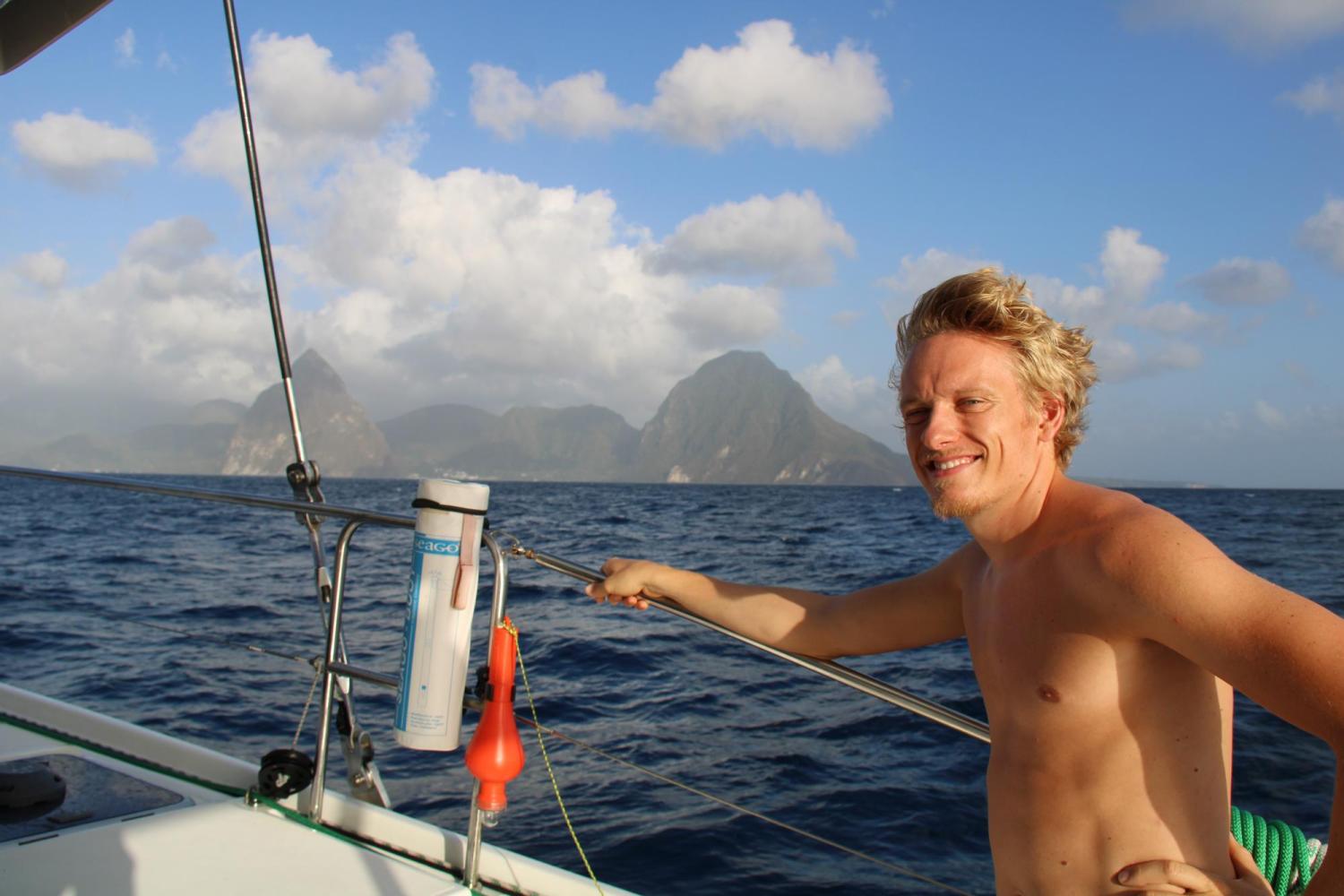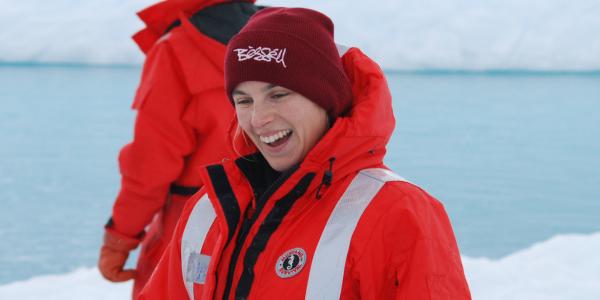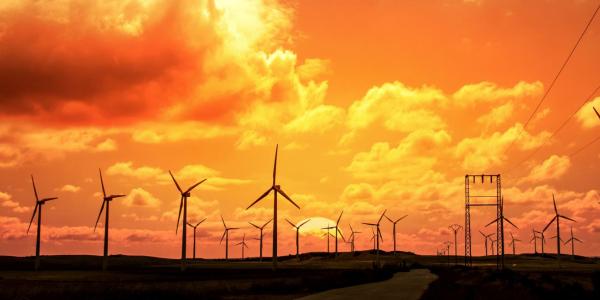Climate researcher eschews air travel on 8,000-mile ‘commute’ to take up INSTAAR position
Climate scientist Joep van Dijk was excited when he received a postdoctoral appointment to the Institute of Alpine and Arctic Research at the University of Colorado Boulder.
 Climate scientist Joep van Dijk near the coast of St. Lucia in the Caribbean. At the top of the page, Dijk is pictured riding near Colorado Springs along Fountain Creek. Images courtesy of Joep van Dijk.
Climate scientist Joep van Dijk near the coast of St. Lucia in the Caribbean. At the top of the page, Dijk is pictured riding near Colorado Springs along Fountain Creek. Images courtesy of Joep van Dijk.
But the good news also presented a conundrum: Concerned about his personal carbon footprint, he didn’t want to fly from his home in Amsterdam to take up the new job. According to some studies, a round-trip flight from New York to Europe can create a warming effect equivalent to 2 or 3 tons of carbon dioxide per person, or nearly 16 percent of the average American’s annual carbon output.
“I thought, ‘I have three months, let’s see if I can get to Colorado without flying,’” says van Dijk, who specializes in paleo-oceanography and paleoclimatology.
He’d soon come up with an ambitious plan: He’d sail across the Atlantic, then bike from his U.S. port of call to Boulder. And that’s just what he did, in 87 days.
“I arrived by bike in Boulder Sunday, March 31,” he says. “Monday was my first day of work.”
The time and effort to make his more-than-8,000-mile journey was considerable, but worth it, van Dijk says.
“When I arrived at my new house in Boulder, I met a woman and the first thing she asked was, ‘How much did you grow throughout your trip?’ It’s such a good question” — and unlike the usual questions he got along the way, he says. “The answer is that I have grown as much as I would have in five years’ time. I would not underestimate the personal development you may experience if you take a slower way to travel.”
More than anything, van Dijk wanted his slow-boat-and-bike trip to serve as an example.
“It’s not that difficult. It takes a bit of energy, but it will make you pretty happy in the long term to know that you didn’t contribute to the (climate change) problem,” he says. “And I’m pretty sure that within a couple of decades, all these things I’m doing will become normal.”
He took video and photos along the way, and is now crowdfunding to raise funds to produce a documentary titled, “Carbon Dioxide? That’s Not Right!”
“Initially, I didn’t want to make a movie of it,” van Dijk says. Then his sister, Puck van Dijk, gave him a present for his PhD graduation on one condition: “I’ll give you this drone, but only if you document the entire trip.”
Van Dijk started his odyssey by searching online for someone to sail with. That’s where he met Captain Robert Bachmann, a German man planning to sail his roughly 40-by-15-foot catamaran, Namaka—named after a Hawaiian sea goddess—from the Canary Islands to the Caribbean.
Van Dijk had participated in a “couple of sailing camps” growing up in the Netherlands, but was no seasoned sailor. In order to gauge how he might fare on a three or four week transatlantic journey, Bachmann agreed to meet him in Spain for a six-day shakedown cruise to the Canary Islands.
“I’d never done something like this before,” Van Dijk says. “We wanted to see if it would be a match, a sort of trial, for seasickness and things like that.”
Van Dijk left Amsterdam by train Jan. 2 for Almeria, Spain, where he met Bachmann. Sailing through the straits of Gibraltar to Las Palmas, on the island of Gran Canaria, he passed his shakedown practicum with flying colors.
“He took me on for two reasons. He liked the idea of a documentary, and was a documentary maker himself. And if need be, he was capable of doing the crossing himself, without help,” van Dijk says.
The Namaka embarked from Las Palmas with Bachmann, van Dijk and two German passengers aboard on Jan. 18. They encountered mostly smooth sailing over the next several weeks, except for some doldrums—areas of low or no wind—that forced the captain to alter his route, and arrived in Barbados on Feb. 10.
When the other two passengers decided to leave the expedition earlier than anticipated, Bachmann asked van Dijk to crew for another couple of weeks’ sailing around the Caribbean, from St. Lucia to George Town, capitol of the Bahamas.
“That was also a very nice and interesting part of the trip,” van Dijk says. “It’s a lot of work to manage a big boat with just two people.”
From George Town, he took three ferries to Florida, where he boarded a red-eye Greyhound bus for New Orleans. There, he bought a bike and began the final, 1,400-mile leg of his journey on March 11. Three weeks later, he showed up at INSTAAR to start his new position researching—as he put it in lay terms—“How did the earth’s marine ecosystem respond to the meteorite that wiped out the dinosaurs?”
Van Dijk has been interested in climate science since high school, where he designed a solar panel with an eye toward fueling his school through solar energy. Undergraduate research in Spain showed him the importance of the geological record in understanding climate issues. As a graduate student, he worked in Switzerland helping to reconstruct the terrestrial climate of the early Eocene period.
His increasing knowledge about climate change inspired van Dijk to begin making changes to his lifestyle. He became a vegetarian—a 2016 study by scientists at the University of Oxford found that widespread adoption of a vegetarian diet would reduce carbon emissions by as much as 63 percent, and a vegan diet by as much as 70 percent—and began to balk at having to fly to conferences and do field work.
Van Dijk recognizes how deeply ingrained luxuries such as air travel and meat-based diets have become in the lives of many Americans. But, he says, it’s possible to make changes incrementally, such as by starting with a “meatless Monday” then increasing the number of meatless days. And he believes that “slow travel” is ultimately more rewarding than winging it to a beach for a week and returning, exhausted and harried.
“My own trip took 87 days. There is a lot of stuff to be seen between Boulder and the Mediterranean,” he says. “If you take a plane to the other side of the world, apart from the fact that it’s completely unnatural and you have no time to adapt, you also miss everything in between.”
A transition to slower travel would require fundamental shifts in how Americans work, he acknowledges, including shorter hours and more vacation time. But that’s all to the good, van Dijk says.
“In Scandinavia, there are 30-hour work weeks, and productivity actually goes up,” he says. “And especially in the U.S., we must leave behind the two-week (vacation time); it must become at least six weeks.”
In the end, he says, taking personal action to mitigate climate change will make us happier.
“As a geologist, I’m trained to think in terms of 50 or 60 million years. Of course, I care about my own life, and I take pleasure in life once in a while,” he says.
“But when you look at your own life and try to make sustainable choices, that will make you happy. Because what is the point of personal growth and happiness if you cannot pass it on? Your grandchildren won’t be able to experience the same things as you, and I think that’s very selfish.”



